Статьи журнала - Siberian Aerospace Journal
Все статьи: 363

Self-Configuring Genetic Programming Algorithms with Success History-Based Adaptation
Статья научная
In this work, a novel method for self-tuning genetic programming (GP) algorithms is pre-sented, based on the ideas of the Success History based Parameter Adaptation (SHA) method, originally developed for the Differential Evolution (DE) algorithm. The main idea of the method is to perform a dy-namic analysis of the history of successful solutions to adapt the algorithm's parameters during the search process. To implement this concept, the operation scheme of classical GP was modified to mimic the DE scheme, allowing the integration of the success history mechanism into GP. The resulting algorithm, de-noted as SHAGP (Success-History based Adaptive Genetic Programming), demonstrates new capabilities for parameter adaptation, such as the adjustment of crossover and mutation probabilities. The work also includes a detailed review of existing self-tuning methods for GP algorithms, which allowed for the identi-fication of their key advantages and limitations and the application of this knowledge in the development of SHAGP. Additionally, new crossover operators are proposed that enable dynamic adjustment of the crossover probability, account for the selective pressure at the current stage, and implement a multi-parent approach. This modification allows for more flexible control over the process of genotype recombination, thereby enhancing the algorithm's adaptability to the problem at hand. To adjust the probabilities of applying various operators (selection, crossover, mutation), self-configuring evolutionary algorithm methods are employed, in particular, the Self-Configuring Evolutionary Algorithm and the Population-Level Dynamic Probabilities Evolutionary Algorithm. Within the framework of this work, two variants of the algorithm were implemented – SelfCSHAGP and PDPSHAGP. The efficiency of the proposed algorithms was tested on problem sets from the Feynman Symbolic Regression Database. Each algorithm was run multiple times on each problem to obtain a reliable statistical sample, and the results were compared using the Mann–Whitney statistical test. The experimental data showed that the proposed algorithms achieve a higher reliability metric compared to existing GP self-tuning methods, with the PDPSHAGP method demonstrating the best efficiency in more than 90 % of the cases. Such a universal self-tuning mechanism can find applications in a wide range of fields, such as automated machine learning, big data processing, engineering design, and medicine, as well as in space applications – for example, in the design of navigation systems for spacecraft and the development of control systems for aerial vehicles. In these areas, the high reliability of algorithms and their ability to find optimal solutions in complex multidimensional spaces are critically important.
Бесплатно
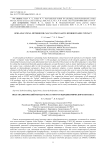
Semi-analytical method for calculating elastic-hydrodynamic contact
Статья научная
A semi-analytical method for calculating elastic-hydrodynamic contact based on the partial use of Computer Aided Design / Computer Aided Engineering (CAD / CAE) packages and solutions of the integral equation of functional relationship between pressure and deformation have been described. The pressure in the lubricating layer is described by solving the modernized Reynolds equation taking into account the factors such as elastic deformation of surfaces in the contact zone, cavitation effect in the low-pressure region, and variable viscosity of the lubricant layer, which depends on thermodynamic parameters. Based on the stationary solution, a tensor damping coefficient has been obtained, with the help of which calculations of transient non-stationary modes that occur in cases of a sharp change in the external load have been further performed. A comparison of the results of modeling a plain bearing obtained by using the proposed semi-analytical method has been made and the full calculation performed using CAD / CAE programs such as ANSYS and COMSOL Multiphysics. The comparison showed good convergence of all numerical methods. At the same time, the “hybrid” method showed a number of advantages over direct calculations in CAD / CAE packages, such as: faster calculation speed, low requirements for computing resources and accounting for the cavitation effect. The described semi-analytical method allows to create digital twins of bearing units, centrifugal pumps and hydraulic supports used in satellite cooling systems and in rotary mechanisms of ground-based satellite dishes.
Бесплатно

Simulation computer model for virtual research of optoelectronic measuring systems
Статья научная
The paper considers a simulation computer model of an optoelectronic system for measuring the point objects coordinates. The model allows optimal coordination of the system links parameters in order to minimize the measurement error. The method of multiple statistical tests which allows accumulating the results of single computational experiments for each specific measurement event with a unique random distribution of links parameters and characteristics, and then carrying out statistical processing of the accumulated results is the main method of computer simulation. As a result of multiple analyses, multi-parameter functional dependencies that provide optimal coordination of parameters controlled by the designer or operator according to the criterion of the resulting measurement error minimizing are realized. The article presents the results of evaluating modeling parameters that reduce the measurement error. It is relevant to apply this method when using the same measuring system in different operating conditions, for different measured objects and when performing various functional tasks since it allows adapting the system for a specific application. The model presented in the article can be concretized for the purpose of evaluating and multi-parameter optimization of particular object parameters, as well as for developing a virtual measuring stand on the basis of the model and its modifications.
Бесплатно
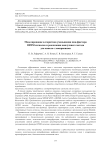
Статья научная
The implementation of efficient communication systems with high data transfer rates requires the usage of signals with a high modulation order. Current trends in the development of communication systems are aimed at orthogonal frequency multiplexing of signals (OFDM – Orthogonal Frequency Division Multiplexing) usage, which allows you to flexibly change the data transfer rate, to reduce the frequency resource by improving spectral efficiency, as well as to combat frequency-selective fading and selective interference. However, the price of such a solution is also high. The high peak-to-average power ratio (PAPR) OFDM signals imposes a requirement for the linearity of the analogical path, significantly reducing the efficiency of the transmitter and receiver output amplifiers, increasing the dimensions and power consumption of the communication system as a whole. The practical novelty of the work lies in the possibility of using the developed method for reducing the PAPR factor in systems with complex communication channels, such as troposcatter and near-field magnetic induction communication systems, where significant effect of selective interference, intersymbol interference, and frequency-selective fading is present. The results of this work give the opportunity to navigate a large number of algorithms for reducing the peak factor of OFDM signals and apply the desired algorithm in a specific task.
Бесплатно
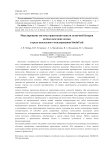
Статья научная
Obtaining electricity from renewable energy sources is primarily due to the exhaustion of traditional natural energy sources, such as coal, oil, gas. Today it is a promising area of development. The adverse impact on the environment of the use of traditional energy technologies is well known and scientifically proven. The use of traditional technologies inevitably leads to climate change, so the topic of the transition from traditional to alternative energy sources is undoubtedly relevant. Using of solar power plants with photovoltaic modules recently has gained relevance. However, the efficiency of such installations depends largely on their correct orientation to the Sun: the more precisely the system is installed, the more energy it will be able to convert. This article presents the results of the development of a simulation model of the solar panel orientation control system. To maximize the production of solar energy, the control system with tracking the Sun is built using fuzzy logic: fuzzy rules are formulated to control the positions of the object relative to the vertical and horizontal planes. The use of fuzzy logic is based on the product model of knowledge, which implies the use of linguistic variables to avoid the limitations inherent in classical product rules. The use of fuzzy control allows to correct the movement of the panel in the shortest time in the autonomous mode, thus reducing the arising power losses. Russian SimInTech dynamic simulation environment for technical systems is used as the system development environment. Simulation model is represented by several subprojects, united in a single database. The system model is implemented using standard blocks and a set of submodels, as well as a programming unit. The result of the work can be tracked in the 3D module of the built-in visual editor, which allows you to display the interaction of three-dimensional models objectively. In order to simplify and more finely implement the work of the project, a system of loading data, sunrise and sunset points, from an external Excel file was used.
Бесплатно

Simulation of the induction soldering process of waveguide paths from aluminum alloys
Статья научная
A system of waveguide paths is a complex structure of various elements with various geometries. Induction soldering based on the induction heating method is one of the promising methods for waveguides fabricating. Induction soldering of waveguide paths has a number of technological features: the melting temperature of the base material AD31 (695–663 0C) slightly differs from the melting temperature of St. AK12 solder (577–580 0C) at an average induction heating rate of 20–25 0C / sec; a wide variety of standard sizes of waveguide paths elements complicates the development and subsequent reproduction of technological parameters of the induction soldering process; zones of maximum heating of waveguide paths elements do not coincide with zones of soldering. Therefore, to solve the problems of controlling the waveguides soldering process, it is necessary to simulate this process. The paper deals with the problem of simulating the process of heating a waveguide during induction soldering. Requirements for the process model have been formed. The model is built on the basis of the differential heat conduction equation. The formed model requirements take into account the geometric parameters of waveguides, the physical parameters of materials, the initial and boundary conditions, as well as the uneven distribution of eddy current density in the waveguide. It is proposed to use the finite difference method for the numerical solution of the heat conduction equation. The process of calculating the temperature at the grid nodes is shown. The authors propose a two-stage solution. At the first stage, at an intermediate time step, the temperature at the grid nodes along the X axis is calculated. At the second stage, the temperature at the grid nodes along the Y axis is calculated. The numerical solution of the difference equations along the X and Y axes is carried out by the sweep method. An algorithm for the numerical solution of the heat conduction equation has been developed.
Бесплатно

Simulation of the mode of electron-beam welding of a thin-wall structure from AD31 alloy
Статья научная
The article contains the results obtained by the authors in the study of the possibility of using electron beam welding (EBW) for thin-walled structures made of AD31 aluminum alloy. Today, EBW of similar de-signs are not used due to the lack of technology. Currently, other technologies for connecting similar struc-tures are used in production, but they have a high cost, the reason for which is due to the high percentage of defects. The method of using EBW proposed by the authors will significantly improve the quality of the joint in thin-walled structures and the reproducibility of the technological mode of welding products. The authors have developed a technological solution to the presented problem, based on many years of experi-ence in the use of models of thermal processes, accompanied by electron beam welding. As a subject of research, modeling of the parameters of electron-beam welding of thin-walled pipes for waveguide paths made of aluminum alloy AD31 is proposed. The article presents the results of mathematical modeling of technological parameters during heating of an aluminum alloy by energy sources equivalent to an electron beam during EBW. The analysis and evaluation of the simulation results was carried out using the optimal-ity criterion developed by the authors. The calculations performed by the authors are based on functional using mathematical models of metal heating by a complex heat source consisting of moving instantaneous point and linear energy sources. The article presents the results of calculations for a plate with a thickness of 0.12 cm, which corresponds to prototypes used in the manufacture of waveguide paths. As a result, by changing such values as: beam current and welding speed, the temperature distribution on the surface of the product during the EBW process was obtained, which showed the applicability of modeling for develop-ing a new technological process.
Бесплатно
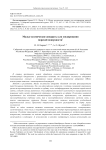
Small satellites for sea surface sounding
Статья научная
The paper presents a method of processing signals of radar sensing of the underlying surface using il-lumination from existing spacecraft (navigation, communication) and a constellation of small receiving spacecraft using synthetic aperture antennas. Methods and Results. Small spacecraft have many advantages over large satellites. Thus, they are rela-tively inexpensive to build, take minimal time from design to launch, can be easily modified to solve a particu-lar problem, and create less radio interference. The approach under consideration consists in redistribution of tasks to be solved between the constellation of satellites in orbit. Both regular high-orbit communication satellites and low-orbit satellite communication systems, as well as navigation satellites are represented as transmitter carriers (underlying surface illumination). These space systems use the necessary broadband sig-nal. Receivers of reflected signals are placed onboard small spacecrafts, and one of the tasks of the system is to perform research experiments, including on-line monitoring of fast-moving atmospheric cyclones. The work applies the method of sea surface radar imaging based on reflected signal models. The main results of the research are as follows: (1) possibility to use as a probing signal both a pulse and a broadband signal with a priori unknown modulation law, (2) acceptable resolution, (3) possibility to significantly reduce the system cost as compared to the existing space radars of sea surface survey. Conclusions. As a result of using a multi-position radar system, which uses small receiving antennas with synthetic aperture and sea surface illumination from operating spacecraft, it is possible to move to a qualitatively new level of solving problems of sea surface remote sensing with spatial resolution up to 1 meter, regardless of illumination and cloud cover presence.
Бесплатно
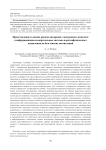
Статья научная
The development of unmanned aircraft systems is becoming one of the key areas of Russia's scientific and technological development. Within the framework of the approved strategy until 2030, it is planned to form a new industry specializing in the creation and use of civilian drones, and priority areas for the development of unmanned technologies have been identified. The great potential for the use of unmanned vehicles is observed in the creation of geospatial databases. In this connection, when using autonomous aerial platforms for aerogeophysical works, the issues of improvement and development of information-measuring systems used on such carriers, as well as the issues of training of operators of aerogeo-physical systems become relevant. The development of algorithmic and software of information-measuring systems on the basis of implementation of previously created electronic content: reference materials, instructions for work, operation of instrumentation products, protocols for processing of obtained results, decisionmaking techniques, etc. is becoming important. However, the application of such electronic content carries risks of reducing the quality of surveying works. One of the ways of risk assessment is to combine the traditional qualitative and categorical approach of modern risk management with multilevel representation of the hierarchy of aggregation of expert-assessed risks in the composition of summary and integral risks by applying the apparatus of soft computing. For systematization and prioritization of risks it is proposed to use gradation scales and terms of linguistic variables of risk components associated with the probability of occurrence of a decrease in the quality of content of information support of operator training systems, with the potential value of possible damage in the event of the fact of a decrease in the quality of information support. As a result, it becomes possible to develop a risk-assessment model, which is a procedure for the specific construction of matrices of consequences and probabilities for individual risk-indicators of the assessment of the integration of electronic content in the information support of training systems for operators of information-measuring systems of aerogeophysical applications. This procedure is a logical basis for calculation of summary and integral values of risk-indicators of assessment, as well as gradation of risk levels.
Бесплатно
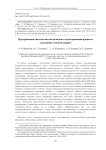
Software system for mathematical simulation of the electronic beam welding process
Статья научная
Within the framework of this study, a software system for modeling the distribution of the temperature field in the steady-state mode of the electron-beam welding process for thin-walled aerospace structures is proposed. The purpose of creating such a software system is to improve the quality of control of the electron-beam welding process and, accordingly, to reduce the number of defects in welded joints of thin-walled structures. The software system has a model structure and implements the energy distribution models proposed earlier by the authors. The MySQL database management system and the Embarcadero RAD Studio programming system were chosen as the means of implementing the program. The central link of the system is a database that allows you to store and process information both on mathematical modeling and on the results of simulation and field experiments. The article describes the structure of the developed software system, and also presents algorithms for the operation of its constituent modules. The system provides the user with the opportunity not only to carry out simulation according to the specified technological parameters (welding speed, accelerating voltage, beam current, boundary conditions, simulation time, product material), but also to visualize the results and save them in a single database. The use of the proposed system allows not only to minimize the costs of the enterprise for the development of technological parameters of the steady state for the electron-beam welding process, but also to create a flexible information base for collecting experimental information with the aim of further automating and intellectualizing the technological process of creating permanent joints in the framework of Industry 4.0.
Бесплатно

Solar thermal propulsion systems with various high-temperature power sources
Статья научная
The paper provides an overview of space thermal propulsion (STP) systems using concentrated solar energy as the main source of power. The paper considers solar thermal rocket engines of various configurations including those with afterburning of hydrogen heated in the “concentrator – absorber” system (CAS) with various oxidizers. Together with hydrogen the oxidizers form high-energy fuel compositions with a high value of ratio of components mass flow-rates which allows reducing the dimension of the CAS. The extreme dependences of the engine thrust on the specific impulse are shown for various values of the hydrogen heating temperature and the oxidizer-to-fuel ratio. The coefficients of the regression dependencies for the efficiency of a two-stage absorber and an absorber with the maximum non-isothermal heating having the highest possible energy efficiency are presented. The algorithms for calculating the main design parameters of the STP system as a part of a spacecraft (SC) are given, taking into account the ballistic parameters of the multi-turn transfer trajectory with multiple active segments applied to the STP systems having an energy-efficient non-isothermal CAS. The engine configurations with thermal heat accumulation and possible afterburning of heated hydrogen are also considered. Thermal accumulation allows accumulating energy in the solar-absorber during passive movement in the illuminated portions of the transfer orbits regardless of the lighting conditions of the apsidal orbit portions where the engine is turned on. Suitable heat-accumulating phase transition materials (HAM) such as the eutectic alloy of boron and silicon as well as refractory beryllium oxide are selected for different phases of the interorbital transfer to the geostationary Earth orbit (GEO). The main characteristics of different configurations of the STP systems in the problem of placing a spacecraft (SC) into high-energy GEO orbits are shown. A model of the SCSTP system operation is given taking into account ballistic parameters and the possibility of accumulating thermal energy. It is shown that the oxidizer-to-fuel ratio in STP systems with thermal energy storage (TES) increases with the decrease of the interorbital transfer time. The STP configurations with a two-stage TES showing a large energy-mass efficiency at moderate values of the solar concentrator accuracy parameter are considered.
Бесплатно
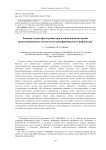
Статья научная
In this paper, we consider the solution of the filtering problem using the Kalman filter with the optimal tuning of the radio-reflecting net. A large-sized transformable space-based reflector is considered. In the process of this structure placing in orbit, it is possible that the real form of the radio-reflecting net can deviate from the desired one. To ensure point-to-point adjustment of the active part of the mesh, a cable-cable system is used. The nodal points of the radio-reflecting surface are connected to the back side of the net through cables. They have built-in actuators that allow one to change the length of the cables. A piezo actuator was selected as a control device. By point-by-point adjustment of the piezo actuators the net is stretched to the required shape. This ensures a high-quality radiation pattern and a high signal level when receiving and transmitting data. Specific values of the disturbing influences are given. To measure the supply voltage on the piezo actuator and the cable length, a voltage converter and a laser scanner are used. Possible deviations from the calculated initial position are determined. In accordance with the principle of separation, the estimation problem is solved first, then the control problem. The estimation problem is solved using the Kalman filter. The control problem is solved using the optimal control algorithm according to the hierarchy of target criteria. The results of numerical simulation are presented. The successful solution of the problem is shown with variable values of measurement noise and disturbing influences. Comparison with trajectories obtained applying various optimal control algorithms is given.
Бесплатно

Статья научная
Failures of elements during the operation of technical and many other systems are, as a rule, random in nature. This leads to various models of the recovery process, studied in probability theory and mathematical reliability theory. During the restoration process, failed elements are restored or replaced with new ones, and there is often a change in the costs and quality of the restored elements (time-to-failure distribution functions). The work examines the cost function (average cost of restoration) in the process of restoration of order k1, k2 , in which, according to a certain rule, the costs of each restoration and the distribution functions of operating time change. Considering, that the recovery function (average number of failures) is well studied in reliability theory, a solution to the integral equation for the cost function is obtained through the recovery function of the model under consideration. For the order restoration process 1 2 k , k , a formula is obtained for calculating the cost function through the restoration function of a simple process formed by the convolution of all distribution functions of the periodic part. For practical application, explicit formulas are obtained for the cost function during the restoration process, in which the periodic part is distributed according to an exponential law or an Erlang law of order m with the same exponent α. The resulting formulas can be used to study the properties of the cost function and solve optimization problems in strategies for carrying out the restoration process in terms of price, quality, risk, if, for example, the average number of failures is taken as quality, the average cost of restorations as price, the dispersion of the number of failures as the risk, or cost of restoration.
Бесплатно
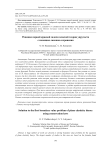
Solution to the first boundary value problem of plane elasticity theory using conservation laws
Статья научная
A huge number of works are devoted to solving boundary value problems for the equations of plane elasticity theory. The largest number of studies in this area are based on the formula found by G. V. Kolosov. He was the first to express the general solution to the problem of plane elastic deforma-tion by finding two independent functions of a complex variable. This made it possible to apply a welldeveloped theory of analytic functions to solving problems of elasticity theory. Later, the solution method based on Kolosov's formula was developed by his student N. I. Muskhelishvili. But the described method also has significant limitations. It is applicable only to those areas that can be conformally mapped onto a circle. Therefore, other methods for solving elasticity theory problems are also needed, since a large number of practically important problems are solved for areas that do not satisfy this condition. The method developed in the work is based on the use of conservation laws that are constructed for equations describing a plane deformable state. The assumptions made in the work make it possible to construct a solution to the first boundary value problem for arbitrary plane areas bounded by a piecewise smooth contour. In this case, finding the components of the stress tensor is reduced to calculating contour integrals along the boundary of the region under consideration. As in the case considered by G. V. Kolosov, the solution to the problem is based on two exact solutions of the Cauchy – Riemann equations, which have singularities at an arbitrary point in the region under consideration.
Бесплатно

Статья научная
The plane problem for elasticity equations is well studied. It can be explained by its importance for applications and by the fact that the equations can be reduced to the Cauchy-Riemann system. In spite of this importance, exact solutions that would describe the stress-strain state of bodies of finite dimensions are not numerous. Conservation laws for differential equations have been appeared more than a hundred years ago, but, as a rule, they were not used to solve specific problems, but were of purely academic interest. The situation changed with the development of the technique of construction of conservation laws for arbitrary systems of differential equations, and then with the use of conservation laws to solve boundary value problems of the theory of plasticity and elastic-plasticity. In this article, new conservation laws are constructed for the equations of the plane theory of elasticity in the stationary case. These laws form an infinite series, which is closely related to the elasticity equations solving. This fact made possible to reduce solving of boundary value problems, in terms of displacements, to the calculation of contour integrals along the boundary of a domain bounded by the studying elastic body. As it follows from the proposed technique, the studied area can be multiply connected, and the considered boundary can be piecewise-smooth.
Бесплатно
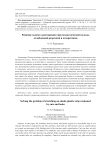
Solving the problem of stretching an elastic-plastic strip weakened by cuts and holes
Статья научная
In this paper, the boundary between elastic and plastic regions in a stretchable strip is con-structed. The band is weakened by side slits and holes. Such tasks are still relevant, since its solution allows us to make an assessment of the limiting state of the structure under consideration. Cuts can have an arbitrary shape, their number is not limited. For simplicity, only sections with rectilinear boundaries are considered in the article. The holes may have an arbitrary shape and be located anywhere in the strip. In operation, only circular holes are considered for simplicity. Numerical methods are currently very often used to solve such a problem, unfortunately, often without much justification. Therefore, analytical methods for solving such problems are becoming more and more relevant. In this paper, the conservation laws of differential equations are used. The conserved current is linear in the first derivatives. The task is solved in two stages. At the first stage, Dirichlet is solved for the Laplace equation, and at the second stage, the technique of conservation laws is used. Their use makes it possible to reduce the finding of the components of the stress tensor at each point to a contour integral along the boundaries of the region un-der consideration. And this makes it possible to build an elastic-plastic boundary.
Бесплатно

Spacecraft motion in a low circular orbit in establishing intersatellite link
Статья научная
The article investigates the problem of inter-satellite linking in the constellation of spacecraft in a low circular orbit. A specific problem of establishing intersatellite link (IL) in that orbit – cross-pointing of the antennae – is also studied. To support cross-tracking, it is important to place spacecraft (SC) in the orbital plane so that they are constantly in the zone of mutual visibility. The line-of-sight range is analyzed both in one orbital plane and between adjacent planes. IL is treated in terms of the orbital constellation (OC) ballistic formation. Several typical modes of motion of SC with IL in adjacent planes are determined – parallel, orthogonal, oncoming. The parameter values of IL antenna pointing are also assessed. The obtained results of OC formation and antenna pointing parameters’ calculations may be relevant for establishing a modified system.
Бесплатно
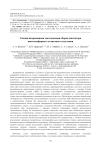
Specialized LED assembly for out-atmospheric solar simulator
Статья научная
Traditional solar simulators for thermal vacuum tests of spacecraft are based on gas-discharge lamps. Due to the characteristics of such lamps, they can only be installed outside the thermal vacuum chamber. High-efficiency LEDs can be installed directly in the thermal vacuum chamber, which can significantly improve the luminous and operational characteristics of solar simulators. Obtaining a spectrum close to the spectrum of the extraterrestrial Sun (AM0) is one of the primary and most difficult tasks in ensuring that the luminous characteristics of the solar simulator meet the requirements. The article considers a pre-viously proposed model of a combined emitter consisting of halogen lamps and assemblies of high-performance LEDs of various wavelengths. We have proposed a method for determining the spectral match for AM0 solar simulators and determined the requirements for LED assemblies intended for use in the combined emitter. Simulation with a sample of the most suitable commercially available LED assembly, at the nominal power level of halogen lamps, showed a good spectral match, which deteriorates significantly with decreasing lamp power. At the same time, many programs and methods of thermal vacuum tests re-quire simulation of different irradiance levels. Taking this into account, the authors developed an experi-mental LED assembly. Simulation of the combined emitter with this LED assembly showed the best results. The required spectral match is maintained at various irradiance levels. The achieved characteristics of the developed LED assembly are not limiting and can be improved by further optimization.
Бесплатно

Статья научная
According to the specific energy consumption, the shaping processes are arranged in three energy levels. Electrophysical and electrochemical methods of metal processing are at the third level, where the specific energy consumption is more than 6·104 J/cm3. The analysis of the literature data showed the inconsistency of the specific costs of some authors. The specific energy consumption of electrical contact processing cannot be commensurate with the costs of electrochemical processing due to the different sizes of the particles removed from the surface of the workpiece. There are no literature data on the specific energy consumption of electro-contact-chemical treatment of metals with a vibrating instrument in the electrolyte, therefore, experiments have been carried out with the fixation of current, voltage and interelectrode gap oscillograms. The method of calculation of specific energy consumption according to the oscillograms of the process is given. The energy costs for vibration of the electrode-tool are calculated, which are an order of magnitude less for electro-contact-chemical treatment. When the vibration amplitude decreases or the voltage on the electrodes increases, the process in the interelectrode gap turns into dimensional arc processing. When electro-contact-chemical treatment of metals with a vibrating tool in water, the specific energy consumption is equal to (3.5–3.8) · 105 J/cm3, which corresponds to electrocontact treatment. It is assumed that the use of aqueous solutions of neutral salts will lead to a reduction in energy costs.
Бесплатно

Статья научная
Active development of science-intensive technologies in the aerospace industry requires consideration of the operation of devices and instruments under extreme conditions; it is important to study the degradation of materials during rapid heating and cooling. On the basis of the theoretical and experimental work performed, the authors of the paper consider the degradation of cadmium telluride detectors caused by the development and evolution of a network of point defects resulting from pulsed exposure with a heat dose of about 1,000º С for no more than 10 s, simulating an extreme situation of a short circuit near the detector or direct heating by light pulses. The study showed that the crystalline material quickly degrades under such extreme conditions due to the rapid evolution of the defect network. The phenomenological model of the formation and distribution of defects during short-term exposure of the detector to thermal radiation has been improved. Electron microscopic studies of samples exposed to pulsed infrared radiation showed the development of a dense defect network, vacancy and interstitial defects, their clusters and other damage in all samples.
Бесплатно

